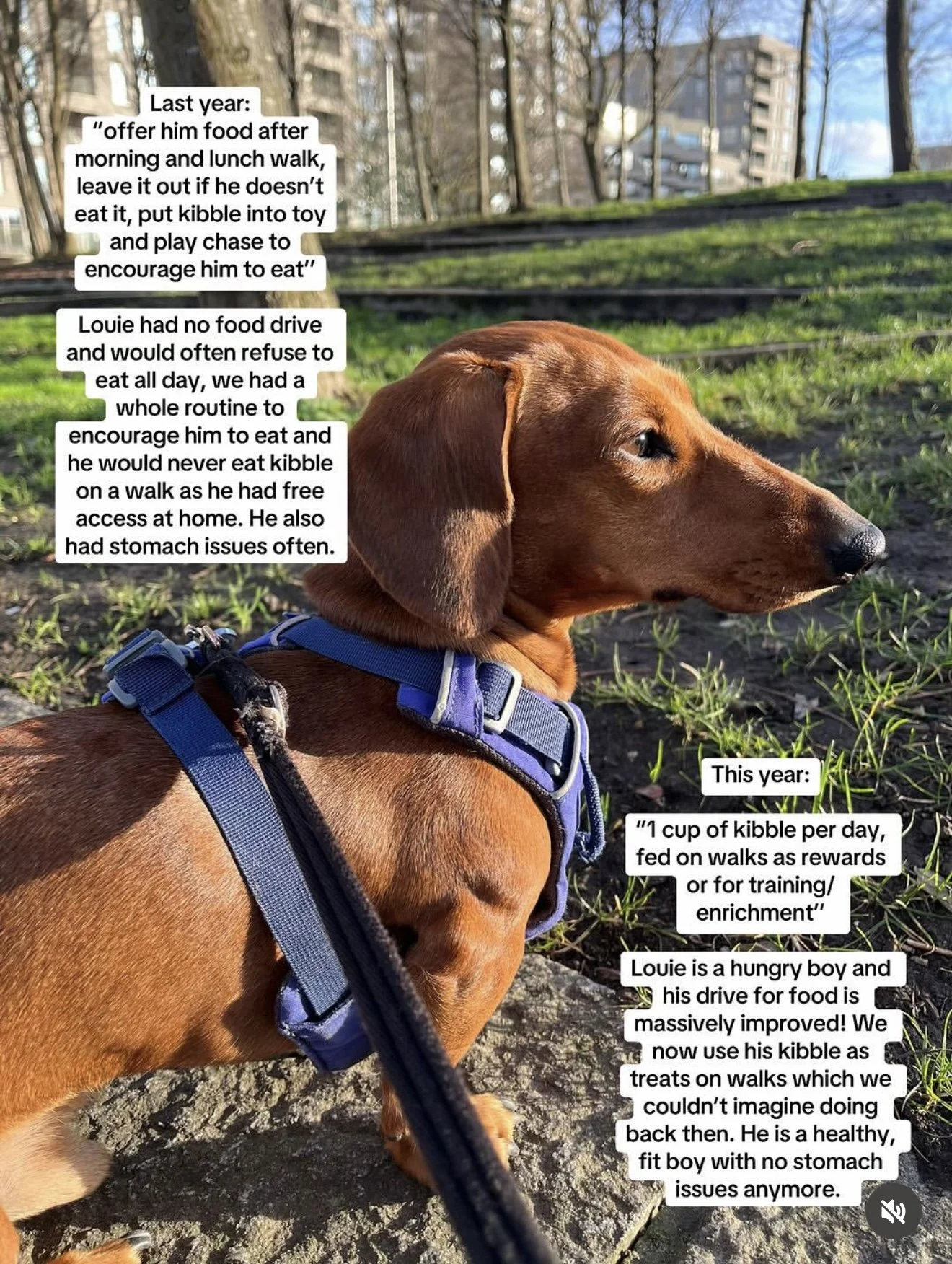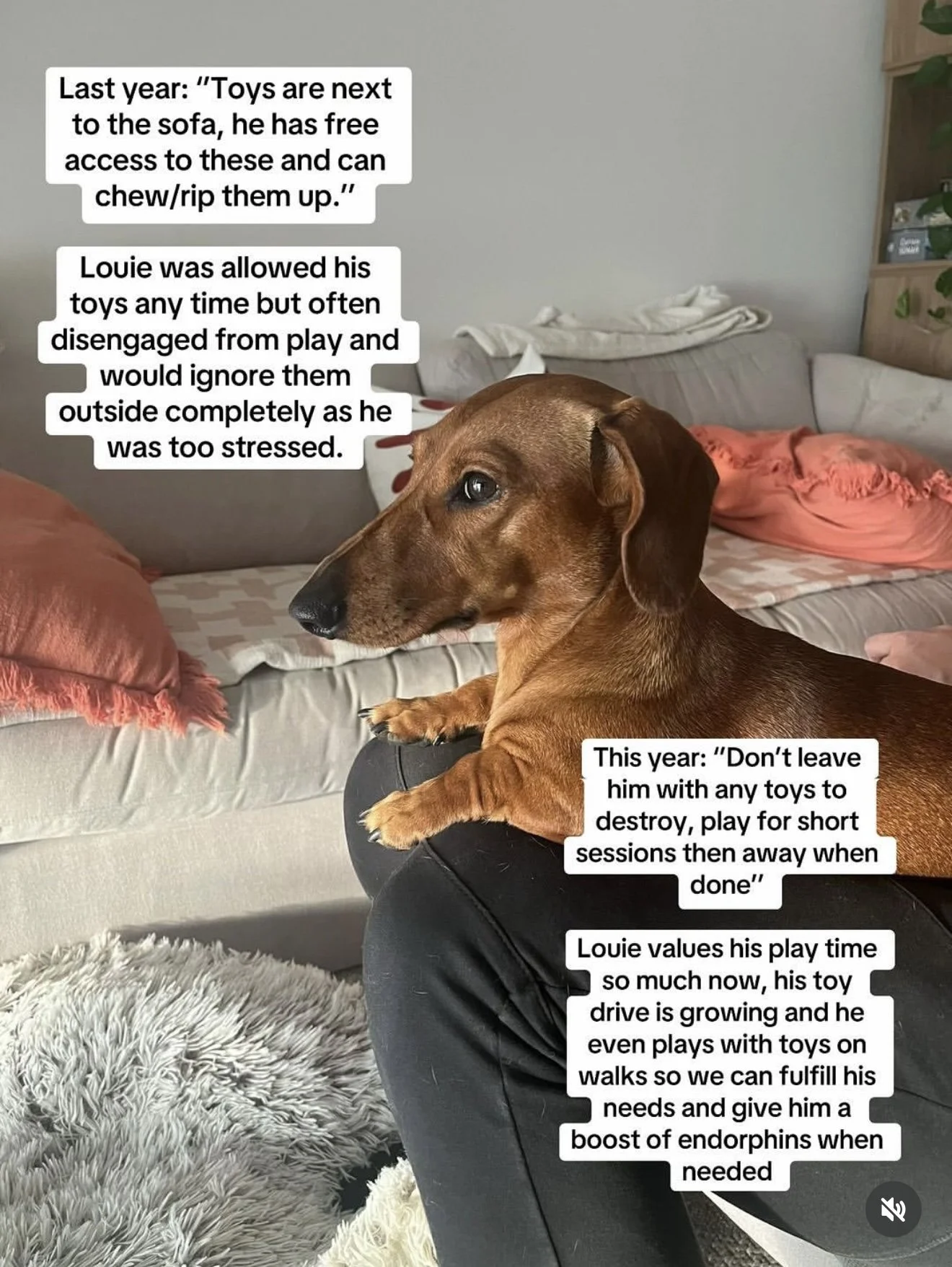From Management to Meaningful Change: Louie’s Honest Hounds Journey One Year On.
A huge thank you to Louie’s amazing owner for sharing his journey with us. This post is taken directly from their Instagram account, where they’ve been documenting Louie’s progress over time. It’s always so powerful to see just how much can change when we shift from managing behaviour to understanding it. Louie’s story is a brilliant example of the progress that’s possible with patience, structure and the right support around you.
You can follow their journey here: @littlelouiesausag
From Avoidance to Progress
When I sat down to update the notes we leave for our dog sitter recently, I didn’t expect it to hit me quite so hard. The last time we rewrote them was in September 2024, and looking back on those instructions stopped me in my tracks.
I couldn’t believe how far Louie has come in less than a year.
Back then, we were still in full-on survival mode. Everything was built around avoiding triggers, managing stress, and trying to minimise fallout. It felt like we were constantly firefighting. But the version of Louie we live with now is different. Not perfect, not fixed, but thriving in a way I never thought possible.
Here’s just some of what’s changed.
September 2024:
“We normally take him to the grass area across the bridge as it is usually quiet in the morning. Sometimes carry him there if there are lots of dogs around on the way”
Back then, Louie’s reactivity to other dogs meant every walk was planned around avoiding others. We were in complete avoidance mode, and it felt like the training just wasn’t working.
Now:
“Say ‘one, two, look at me’ and then reward if he is fixating. If he does meet another dog, let him sniff for a few seconds then move him along.”
His overreactivity is now rare. We walk past dogs every day with minimal stress. He still fixates occasionally, but now we interrupt and move him on. We’re even working on polite greetings so that seeing other dogs becomes a non-event.
From No Appetite to Eager Engagement
September 2024:
“Offer him food after his walk. Leave it out if he doesn’t eat it. Try putting kibble in a toy or playing chase.”
Louie had no food drive. He’d often skip meals entirely, and feeding him felt like a full-time job. We couldn’t use food for training or engagement, and he had regular stomach issues too.
Now:
“One cup of kibble per day, fed on walks as rewards or for training and enrichment.”
Louie is now food-motivated, focused, and excited to work. His stomach issues are gone, and he’s fit, healthy, and eager to engage. We now use his meals as part of our training routine, something I never imagined possible a year ago.
From Restless to Regulated
September 2024:
“He usually settles on the sofa after playtime. Give him a squishy toy or turn on the noise machine if he struggles to settle.”
Louie didn’t have clear boundaries or a restful routine. If one of us left the room, he’d become highly stressed and alert. Sleep was patchy, and so was his regulation.
Now:
“Louie in his crate to rest.”
Now, he has a clear routine and sleeps well. The crate has become a safe, restful space. He’s no longer stressed by household movement or noises, and we’re even starting to work on home alone time, something that felt impossible before.
From Disconnected Play to Meaningful Interaction
September 2024:
“Toys are next to the sofa, he can access and destroy them freely.”
Louie had toys, but didn’t know how to engage with them. He was often too stressed to play and would ignore toys on walks altogether.
Now:
“Don’t leave toys out to destroy. Play for short sessions then put them away.”
He now values play and looks forward to it. His toy drive is growing and we even use toys on walks to help meet his needs and give him a healthy endorphin boost.
From Medication to Munchies
September 2024:
“Give him a few real treats before the pill treat. He is wary of it.”
Louie was on anxiety medication and struggled with food-based routines.
Now:
Louie is no longer on any medication. He’s confident with food, more optimistic, and happily eats what he’s given without suspicion or fuss.
From Barking and Uncertainty to Calm, Guided Days
September 2024:
“If he goes to the front door and barks, call him back, block the hallway, turn on the noise machine.”
We were managing the barking, not addressing it. He didn’t have any clear feedback or structure for these moments.
Now:
“When you get Louie out of the crate, put the house lead on. Don’t let him roam the flat.”
Now, our routine includes structured uptime and downtime. He knows what’s expected of him, barking is rare, and the clarity in our communication has made a huge difference.






